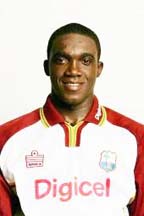In DUNEDIN
Jerome Taylor’s exceptional hundred in the first Test here Sunday has set standards for all aspiring West Indies’ bowlers to follow.

Head coach John Dyson has pressed the need for the bowlers to pay more attention to their batting and captain Chris Gayle emphasised it yesterday with specific reference to Daren Powell, a first ball victim at No.9 whose Test batting average is six.
“I’m disappointed with Daren’s batting in the last few months. He needs to step up as he’s a better batsman than that,” Gayle said at the presentation after the match was abandoned as a draw without a ball bowled on the final day because of more of the rain that also eliminated the second day.
There was more than a hint of a warning as Gayle added: “I’m looking for better things from him with the bat.”
It applies to others as well.
Fidel Edwards, Corey Collymore and Pedro Collins, along with Taylor and Powell the recent fast bowlers, all have batting averages of under eight. Lionel Baker was placed at No.11 on debut and none of the emerging bowlers, fast or slow, are even close to the all-round category.
The brittleness of the lower order has been one of the team’s weak points in its long period of decline.
Prior to Taylor’s stroke-filled 106 off 107 balls that dominated a record seventh wicket partnership of 153 with Shivnarine Chanderpaul, the last time the last four West Indies wickets contributed over 100 was against England at Lord’s in May 2007, 13 Tests earlier.
Had it not been for the Taylor-Chanderpaul stand, the West Indies, 173 for six when it started, would have struggled to total 200. The other scores from No.7 down were 6 (Denesh Ramdin), first ball 0 (Powell), 0 (Edwards) and 0 not out (Baker).
It is unrealistic now to expect regular hundreds from those who seem incapable of putting together even 10 – or from Taylor himself, for that matter. But he has shown what can be achieved with application.
“The coaches keep telling me I have the ability to be an all-rounder and I’m taking my batting seriously and working very hard,” he said.
He revealed that he gets the chance to go in early at practice which gives him time to focus on his batting. In the past, bowlers found they were relegated to batting in the nets only after the batsmen were through.
Taylor is the first genuine fast bowler – Garry Sobers excepted – to score a Test hundred for the West Indies.
Keith Boyce (95 not out against Australia in Adelaide in 1975-76); Malcolm Marshall (92 against India in Ahmedabad in 1983-84) and Learie Constantine (90 against England in Port-of-Spain in 1935) came closest.
Only five others have compiled hundreds at No.8.
They were Robert Christiani against India in Delhi in 1948-49, Clairemonte dePeiza in his record 347-run partnership with Denis Atkinson against Australia in 1955, Gerry Alexander against Australia in Sydney in 1960-61, Bernard Julien against England at Lord’s in 1973 and, with night watchman Winston Davis and Jeffrey Dujon batting before him, Clive Lloyd against India in Antigua in 1983.
While he didn’t doubt he had it in him to achieve the feat, it came a little sooner than Taylor anticipated. After all, his highest first-class score had been 41.
“I wanted to take it a step at a time, get a half-century first and try to move to a century,” he said. “It all came at once.”
It has provided a psychological fillip to the team entering the second Test that starts in Napier on Friday.
The series is what the headline writers here have deemed “the battle of the cellar dwellers” with West Indies rated No.7 and New Zealand No.8 of the nine International Cricket Council (ICC) full members.
Another draw would leave positions as they are. They would be swapped against with a New Zealand victory.
Ian Smith, the former New Zealand wicket-keeper, now television commentator, who lives in Napier, said the pitch should be “a belter” and the weather much better.
“This was a pretty good pitch here but there should be a little more pace and bounce at McClean Park (the Test venue),” he said. “It’ll be even and really good for batting.
Dunedin was frigid throughout with the temperature never above 14 degrees and just touching 10 degrees on the third day, all accentuated by a stiff wind.
Rain that caused the loss of two and a half days was never far away.
Napier is on the east coast of New Zealand’s north island and is supposedly warmer and more settled. But rain allowed less than a day all told in the last Test the West Indies played there three years ago.
The teams are well matched and have everything to play for. Another weather-beaten Test would be frustrating anti-climax.





